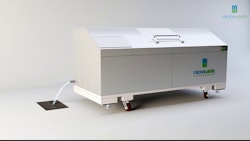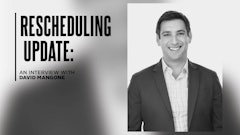
Because cannabis remains federally illegal in the United States, businesses in the industry face unique challenges when accessing capital. Companies that seek funding must go beyond traditional initial public offerings (IPOs) that are generally not permitted in the U.S. and explore lesser-known transactions to raise funds.
Marcum recently completed the work on the first special purpose acquisition company (SPAC) in the cannabis space, and is handling an IPO for a cannabis oil extractor in California that intends to list on the Canadian Securities Exchange (CSE). In an IPO, the stock of a private company is offered for the first time to the public, and an underwriting firm helps the issuer determine what type of security to issue, the best offering price, the number of shares to issue and the time to bring it to market. A SPAC is a publicly-traded buyout company that raises collective investment funds in a blind pool of money, through an IPO, to complete the acquisition of an existing private company, which can be in a specified target industry. In a SPAC, the money raised through the IPO is put into a trust where it is held until the SPAC identifies an opportunity to acquire or merge.
According to Marcum’s vice chairman, David Bukzin, “Marcum always [goes] wherever the capital markets go and wherever the industries are that are starting to attract public equities.” The company handles SPACs, blockchain and cryptocurrency, and began working with the cannabis industry last year, Bukzin says.
Here, Bukzin discusses how cannabis businesses can navigate IPOs, SPACs and Reg A+s to secure capital.
Cannabis Business Times: Can you describe the process for a company to become a SPAC and what role Marcum played in this process to help the first SPAC in the cannabis industry become a reality?
David Bukzin: Each year, it gets more and more difficult for [any] new listings, for various reasons, to come onto public markets. Over the last number of years, there have been less publicly traded companies at the end of the year than at the beginning of the year because of going private, [being] bought [or] sold, bankruptcy, etc. The capital market, the regulatory agencies, the NASDAQ and the NYSE had to figure out a way to get new product onto the exchanges. One of the ways that has become popular is a SPAC. There were about 215 IPOs in 2017. Thirty-four of them were SPACs. So, that’s become a significant market share. A little over 15 percent of all IPOs were these SPAC structures.
The SPACs begin with a traditional IPO, as far as the SEC [Securities Exchange Commission] is concerned. They file a registration statement on a form S-1, [an SEC filing used by companies planning to go public to register their securities with the SEC], just like you would an operating business, but you’re doing the IPO around a management team with certain industry or service specialties. [It is a traditional IPO in structure, but not traditional because there is no business that is going public. Instead, you are taking a management team with a pool of cash public]. And then the IPO gets completed, and then you have what we call the second phase of the SPAC, which is the maintenance phase, [which is] filing 10-Qs, [comprehensive reports of the company’s performance that are submitted quarterly to the SEC], and a 10-K, [an annual report to the SEC that gives a comprehensive summary of the company’s financial performance], just like every other public company. But during this period, the management team is actively looking for targets, [or companies in the specified industry], for the SPAC to merge with. [A good candidate to merge with has good public company comparables, a seasoned management team, good corporate governance and, generally speaking, they are using the SPAC capital for growth]. Once they find a target, they go into the de-SPACing phase, and that’s where you file with the SEC for a merger of this private company or an acquisition with the SPAC, and you put a vote out to the shareholders, and the transaction hopefully closes, and then the SPAC will [generally] change their name to the name of the private company.

Photo: © miztanya | Adobe Stock
CBT: What impact does this new SPAC have on the cannabis industry, and will there be more to come in this space?
DB: Part of the reason that we decided to finally dip our toes in [cannabis] is we see a lot more professional management coming into the industry. I guess that coincides with legalization in more and more jurisdictions. So, because of that, naturally more and more capital is going to be pooled and put into business ventures. This SPAC [that Marcum completed], MT ECH Acquisition Corp., raised, I believe, $57 million to merge or buy with a company that’s doing ancillary services to support the cannabis industry. I think it’s very important because it is the first, and I believe I heard there is at least a second one out there, but depending upon the success of the management team in attracting and finding a target, it could be a major way that companies go public and attract significant amounts of capital.
CBT: What steps do companies have to take when going public with an IPO, and how is this process similar to and different from a SPAC?
DB: [With] an IPO, you [generally] have to worry about the markets, [whether the IPO “window” is open or closed, changing valuations, the volatility of the capital markets] and the SEC first before you get your money. You have [to deal] with the filing of the registration statement, and then you get a pricing. And hopefully, the market window is open at that time, the valuations haven’t changed, and then you get your money and you go public.
[With] a SPAC transaction, most of the time [it] is consummated like a reverse merger, and it’s a structured transaction. So, you worry about many aspects of the going-public process that are out of your control after the deal gets structured and outlined. A SPAC transaction—whether in the cannabis or not in the cannabis industry—it takes a lot of the unknowns out of consummating a transaction. The pool of capital’s already there.
CBT: How are cannabis IPOs different in Canada than in the U.S.?
DB: Nobody wants to step on each other’s toes as it relates to what’s legal [federally]. Cronos went public here—they’re on NASDAQ—because they’re not violating any federal laws by having facilities in Canada, Israel and Germany. TSX had taken the stance that they won’t allow U.S.-based companies that are violating federal law by touching [the plant], growing and distributing, so they won’t let U.S. companies go public on the TSX, but the CSE, which is a junior exchange, has agreed to allow these companies to list there. I think it’s a real market opportunity for the CSE because as we all know, the cannabis industry is, in many ways, still at its infancy, and there’s significant growth, and the best way to attract pooled capital and get a fair market value for your equity interest is on an exchange.
It’s unfortunate for U.S. companies that they can’t yet do it on NASDAQ. I’m sure at some point they will because the liquidity and research coverage, [or having analysts track and publish opinions on a company and its stock], are certainly much more available here in the U.S. on NASDAQ than a junior, [or smaller], exchange in Canada.

Photo: © xy | Adobe Stock
CBT: What impact does it have on the cannabis industry as a whole that IPOs are not permitted in the U.S.?
DB: I think it goes back to liquidity and valuation. If a company can raise capital—capital’s capital. So, it doesn’t matter if you raise it on the TSX, the CSE, NASDAQ or the NYSE, in many respects. What’s important is [after] that initial capital. When you go public, you go from having one business to two—the business of whatever you’re in and the business of being public. And once you bring in outside shareholders and you’re no longer a private company, you’ve got to focus on both of those aspects equally, or else being public could have a very negative impact on your business prospects. Therefore, you would like to be trading on the most efficient and liquid markets that exist, and those are the NASDAQ and the NYSE.
CBT: What is a Reg A+?
DB: Reg A+ is another methodology that entrepreneurial companies are using to go public here in the States, and we have at least one cannabis-related company that we’re in the process of taking to a Reg A+. The Reg A+ came out of the JOBS Act and rules were finalized around 2015. It’s an IPO modified to take advantage of certain crowdfunding aspects, and you get the best of both worlds of an IPO and the crowdfunding. For example, when you do an IPO, you’re in a quiet period, but with a Reg A+ offering, you have the ability to test the waters and to use general solicitation to get your offering completed. It’s not done on an S-1, like a typical IPO. It’s done on a form 1-A, [which has less disclosure requirements than an S-1].
There are two types of Reg A+s. There’s a Tier 1, where you can raise up to $20 million, and there’s a Tier 2, which can raise up to $50 million. Initially the rules were designed for you to wind up on the OTC [Over-the-Counter] markets, [or a decentralized market without a physical location]. Once again, we talk about efficiency of a market, liquidity, research coverage and the ability to raise significant amounts of capital. On the OTC markets, that’s a little bit of a challenge. Last year, because you need to find ways to get additional companies onto [exchanges], the NYSE and the NASDAQ changed their rules to allow Reg A+s to go directly to an exchange. Back to my statistic before, of the 215 IPOs in the U.S. last year onto an exchange, 34 were SPACS, eight were these Reg A+s. So, now you’re at 20 percent of the IPOs were these alternative structures.
What’s nice about these Reg A+ Tier 2 offerings is if you can’t raise enough capital to get onto an exchange, instead of killing the offering—which many times has happened—you can now complete the offering and trade on the OTC markets while you work on getting yourself able to meet the additional listing requirements of one of the exchanges. On the smaller side, you’re going to see cannabis-related companies.
My prediction is that you’re going to see IPOs that are close to a billion [dollars] or more [that] always will be done the traditional way. Middle-market IPOs—let’s say $250 million in enterprise to a billion [dollars]—you’re going to see a bigger percentage of that, and SPACs, [in a middle market]. And below that, you’re going to see these Reg A+ Tier 2s become an important part of the market.
CBT: What advice do you have for cannabis companies looking to access capital markets in the U.S.?
DB: In many respects, the exchanges don’t care if you have a lawyer. They don’t care if you have an investment banker. They care about one thing, and the most important thing—that your numbers are accurate and what you’re reporting to investors is true and correct, or at least materially true and correct. You’ve got to build a reporting infrastructure to get that right. There’s nothing worse than a company going public [and] having problems with their numbers. Then they’ve got real problems.
What I call a seller’s due diligence [is also important]. When you’re in a company that needs capital—whether you’re private or public—you’re always selling. You’ve got to have seller’s due diligence in mind. You should have a data room with all your pertinent documents [and] the ability to turn around accurate financials in a timely fashion.
All the other aspects of corporate governance are [also] important—an actively involved board of directors. The various committees—whether it’s an audit committee, a compensation committee, a governance committee. And look 18 months to two years out to what a young company wants to be when it grows up, and start laying in the framework for the future. We’re working with a bunch of oil extractors on the West Coast that are strongly considering—and at least one of them is—lining up to go public on the CSE, and you can certainly see the difference between some of the founders, which are more on the entrepreneurial side of the business, as opposed to the guys that come in—the adults in the room, the board level people and CEOs and chief operating officers—that really bring a discipline to the company to be able to get them to the next level. Some of these companies are growing so fast, it’s like riding a bucking bronco—it’s a challenge.
Editor’s note: This interview has been edited for length, style and clarity.
Top Image: © steheap | Adobe Stock

























